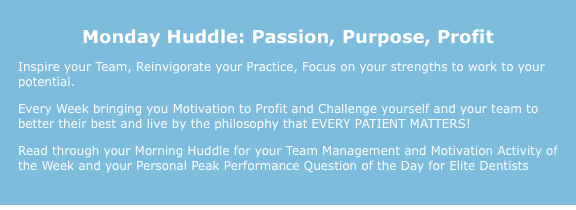Today, we are going to dive deeper into actions that patients make (which you can be a catalyst for), that will tell you whether or not they are going to be a successful patient.
I think it’s time to revisit tips for creating better patients. Here are a few…
A patient who shares more information over the phone about past experiences or about the desire for a healthier mouth or is asking more questions. Even though you want to be in control and the one asking the questions, a curious and inquisitive patient is a good one – it shows interests and seriousness.
You can also accept a form a payment over the phone for a cancellation policy or a reservation fee. The best practices do this seamlessly by simply saying, “One more thing before we hang up, we just need a method of payment to put down on file to hold your appointment. Of course, you pay nothing. It’s simply part of our cancellation policy; if for some reason you wouldn’t give us at least 48 hours notice or not show up for the appointment we scheduled today there would be a $25, $50, $75 appointment charge. Again, nothing to worry about as long as you are here. What credit card would you prefer to place on file?”
It’s straightforward and simple. And if the callers are serious about committing to their appointments, they will offer up the payment. You’ll see nice restaurants do this and naturally hotel.
It’s not for every practice – but responsible patients understand the purpose. Only people who are considering NOT showing up would be hesitant.
It’s just one concept. There are others…
More in depth paperwork, actually filling things out, sending an email or text immediately after the phone call to CONFIRM their appointment – shows a sign of your attentiveness and their affirmation of what they just committed to.
Next, there are things you can do to get your patients to take action that raises their level of anticipation for their appointments. That is what you want; you want them wanting to come in.
This is also the reason why I LOVE the pre-appointment, personalized confirmation call from the Treatment Coordinator (or Patient Concierge) because it builds relationship and it shows you have your stuff together. It also is used to RESELL (I said it… re-SELL) your incoming patients on showing up, on the value they are going to receive and the direct benefit to them so that you are reminding them what they called for in the first place.
Last week, I asked you to reflect and think about what information you need (or want, even better) more of in order to help you be more successful with your patients.
This includes the personal things too. Such as work, marriage, family, neighborhood, passions, hobbies, interests, etc.
Of course, the focus should be on their health and their goals for their mouths, smiles or whatever the key philosophy of your practice is.
The point is simple… The more you know, the more personal and specific you can make your conversations, the patient experience overall, and the more effective your handoffs and transfers can be.
One of the most important protocols you should have mastered in your practice is what SPECIFIC information you want to have with every single triangle of trust and patient handoff.
This means that every team member should know, have practiced, rehearsed, memorized (even taken tests over) what the list of items are and how those items should be conveyed when being passed from one team member to the next.
Phone to Schedule
Schedule to Clinical Team Member
Clinical Team Member to Doctor
Doctor back to Clinical or to Treatment Coordinator
Clinical Team to Treatment Coordinator or Business/Admin Exit
Unless you can pull out a piece of paper with the exact flow of the dialogue that is supposed to be done from one to the next based on each step and stage of your patient experiences (new and existing; emergency and hygiene; operative and specialty; and every single different variable)…
Then you don’t have real protocols.
And this may be the most important protocol of them all. The communication flow, expectations of, specific information about, for each and every triangle of trust and patient handoff and transfer.
By the way, protocol means NOT OPTIONAL; it is no different than THE STANDARD OF CARE in your practice – it is THE WAY you do things. And everyone must follow.
It’s amazing to me (disappointing really is a better word), how casual and lazy handoffs are made with no real purpose and certainly with no actual influence over the patient. You end up leaving your next team member at a disadvantage and undoing anything you actually did effectively and successfully while you were with the patient.
Go to work on this now. Next week, we’ll iron out some details related to other SUCCESS and POWER Protocols that lead to positive and consistent (keyword) outcomes with your patients.
We always end up right back here with communication. Communication Protocols are something most never think about, let alone actually take the time to have. Yet, without clarity and execution, you are really leaving your success up to accidents.
You surely can and want to do better by your patients.
That begins right here.



